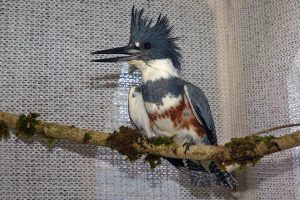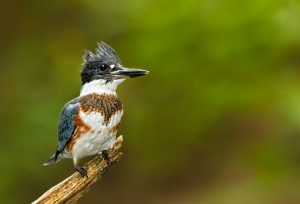Support Us
Since 1979 more than 140,000 animals have been treated by Wildlife Rescue.
Thanks to the support of individuals like you, Wildlife Rescue can provide a lifeline for animals in distress.
As winter sets in, wildlife faces severe challenges – from dwindling food supplies and freezing temperatures to ice-covered water sources. Your generous gift can help provide critical care for these vulnerable animals, offering them the resources they need to survive and recover. With your help, injured wildlife can return to the wild.
Canada is home to a diverse range of birds, and to celebrate them we also must make sure we provide support and conservation efforts to help protect them.

Patrolling up and down the rivers and shorelines, the beautiful Belted Kingfisher with its heavy frame and vigorous flight can easily be spotted. Its small feet and large head give it a unique look. The Belted Kingfisher with a shaggy crest on the top and back of its head and a beautiful blue-gray color and fine white spotting on the wing and tail. Females have a broad rusty band on their bellies.
Belted Kingfishers almost always need access to bodies of water for feeding and vertical earthen banks for nesting. They rely entirely on aquatic prey, diving to catch fish and crayfish in unclouded water that allows them to see their prey below. Often, kingfishers look for prey from a perch that overhangs water like telephone wires, pier piling, and bare branches. They fly up and down rivers and shorelines giving loud rattling calls with the bill downward before diving after a fish they have spotted.
When Belted Kingfishers are mating the male brings fish to the female and feeds her, an act of courtship. Together, they find a nest site that is usually in a steep or vertical dirt bank with sand. They choose a bank near water but sometimes find landfills, sandpit, or a ditch to complete their burrow. The burrow can take 3-7 days for them to complete, as both partners help dig a horizontal tunnel with the nest chambers at the end. The burrow can extend 3-6 feet into the bank and slopes upward to prevent rainwater from coming inside. The undigested fish bones and fish scales provide insulation to their new nest.

Belted Kingfishers can come to backyards that have ponds or goldfish pools in search of prey, however; this can cause challenges. Belted Kingfisher, like this patient in care, can strike into large windows when navigating in suburban neighborhoods.
The windows in our homes are a huge danger to our local birds. In the summer, birds are migrating north to find the best place for nesting and raising their young. As they are navigating our yards they can fly into windows because the foliage and sky are reflecting, making it look as though the animal can fly through. This deceptive illusion often leads to the bird crashing into the window which can result in serious injuries and sometimes death.
During the day, birds may experience a reflection or to see right through the window to the other side. Many bird species are most active at night and can become disorientated by lights shining from windows, often fly toward the light and crash into windows.
In addition, some birds will suffer injuries during mating season when they believe they are defending their territories. The birds see their reflection in the glass and believe it to be another bird, a competing male, and may attack the window with force attempting to scare the intruder off.
Tips to Help Stop Birds from Hitting Windows
|
Of course, we can all do our part and protect injured birds. If you see a bird that has exposed bone or blood, bugs or insects covering it, no feathers, or a bird that is sleeping, human intervention is required. Please contact our Support Centre for assistance.
Help local wildlife return safely to the wild!